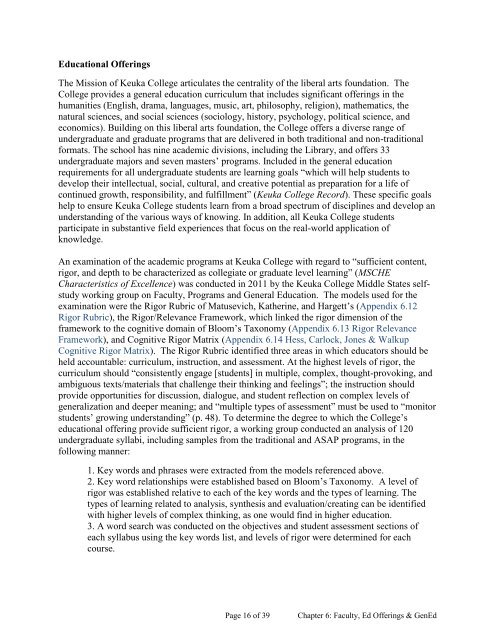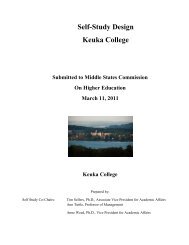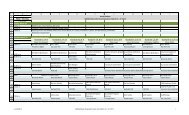final version of the self-study document - Keuka College's Middle ...
final version of the self-study document - Keuka College's Middle ...
final version of the self-study document - Keuka College's Middle ...
You also want an ePaper? Increase the reach of your titles
YUMPU automatically turns print PDFs into web optimized ePapers that Google loves.
Educational Offerings<br />
The Mission <strong>of</strong> <strong>Keuka</strong> College articulates <strong>the</strong> centrality <strong>of</strong> <strong>the</strong> liberal arts foundation. The<br />
College provides a general education curriculum that includes significant <strong>of</strong>ferings in <strong>the</strong><br />
humanities (English, drama, languages, music, art, philosophy, religion), ma<strong>the</strong>matics, <strong>the</strong><br />
natural sciences, and social sciences (sociology, history, psychology, political science, and<br />
economics). Building on this liberal arts foundation, <strong>the</strong> College <strong>of</strong>fers a diverse range <strong>of</strong><br />
undergraduate and graduate programs that are delivered in both traditional and non-traditional<br />
formats. The school has nine academic divisions, including <strong>the</strong> Library, and <strong>of</strong>fers 33<br />
undergraduate majors and seven masters’ programs. Included in <strong>the</strong> general education<br />
requirements for all undergraduate students are learning goals “which will help students to<br />
develop <strong>the</strong>ir intellectual, social, cultural, and creative potential as preparation for a life <strong>of</strong><br />
continued growth, responsibility, and fulfillment” (<strong>Keuka</strong> College Record). These specific goals<br />
help to ensure <strong>Keuka</strong> College students learn from a broad spectrum <strong>of</strong> disciplines and develop an<br />
understanding <strong>of</strong> <strong>the</strong> various ways <strong>of</strong> knowing. In addition, all <strong>Keuka</strong> College students<br />
participate in substantive field experiences that focus on <strong>the</strong> real-world application <strong>of</strong><br />
knowledge.<br />
An examination <strong>of</strong> <strong>the</strong> academic programs at <strong>Keuka</strong> College with regard to “sufficient content,<br />
rigor, and depth to be characterized as collegiate or graduate level learning” (MSCHE<br />
Characteristics <strong>of</strong> Excellence) was conducted in 2011 by <strong>the</strong> <strong>Keuka</strong> College <strong>Middle</strong> States <strong>self</strong><strong>study</strong><br />
working group on Faculty, Programs and General Education. The models used for <strong>the</strong><br />
examination were <strong>the</strong> Rigor Rubric <strong>of</strong> Matusevich, Ka<strong>the</strong>rine, and Hargett’s (Appendix 6.12<br />
Rigor Rubric), <strong>the</strong> Rigor/Relevance Framework, which linked <strong>the</strong> rigor dimension <strong>of</strong> <strong>the</strong><br />
framework to <strong>the</strong> cognitive domain <strong>of</strong> Bloom’s Taxonomy (Appendix 6.13 Rigor Relevance<br />
Framework), and Cognitive Rigor Matrix (Appendix 6.14 Hess, Carlock, Jones & Walkup<br />
Cognitive Rigor Matrix). The Rigor Rubric identified three areas in which educators should be<br />
held accountable: curriculum, instruction, and assessment. At <strong>the</strong> highest levels <strong>of</strong> rigor, <strong>the</strong><br />
curriculum should “consistently engage [students] in multiple, complex, thought-provoking, and<br />
ambiguous texts/materials that challenge <strong>the</strong>ir thinking and feelings”; <strong>the</strong> instruction should<br />
provide opportunities for discussion, dialogue, and student reflection on complex levels <strong>of</strong><br />
generalization and deeper meaning; and “multiple types <strong>of</strong> assessment” must be used to “monitor<br />
students’ growing understanding” (p. 48). To determine <strong>the</strong> degree to which <strong>the</strong> College’s<br />
educational <strong>of</strong>fering provide sufficient rigor, a working group conducted an analysis <strong>of</strong> 120<br />
undergraduate syllabi, including samples from <strong>the</strong> traditional and ASAP programs, in <strong>the</strong><br />
following manner:<br />
1. Key words and phrases were extracted from <strong>the</strong> models referenced above.<br />
2. Key word relationships were established based on Bloom’s Taxonomy. A level <strong>of</strong><br />
rigor was established relative to each <strong>of</strong> <strong>the</strong> key words and <strong>the</strong> types <strong>of</strong> learning. The<br />
types <strong>of</strong> learning related to analysis, syn<strong>the</strong>sis and evaluation/creating can be identified<br />
with higher levels <strong>of</strong> complex thinking, as one would find in higher education.<br />
3. A word search was conducted on <strong>the</strong> objectives and student assessment sections <strong>of</strong><br />
each syllabus using <strong>the</strong> key words list, and levels <strong>of</strong> rigor were determined for each<br />
course.<br />
Page 16 <strong>of</strong> 39 Chapter 6: Faculty, Ed Offerings & GenEd




